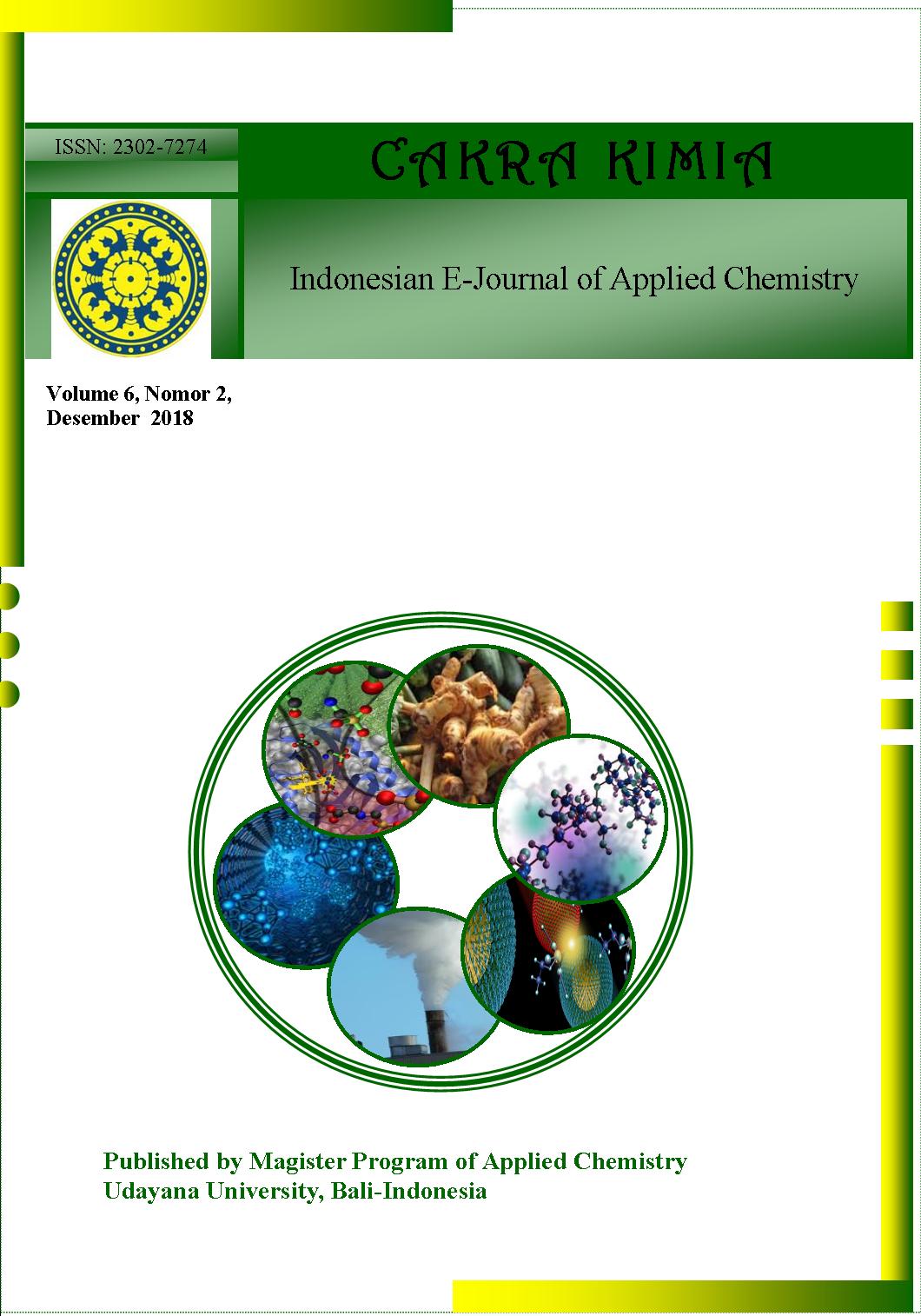HIDROLISIS BATANG JAGUNG SECARA ENZIMATIK DARI TANAH HUTAN MANGROVE
Abstract
ABSTRAK: Tanah hutan mangrove merupakan salah satu sumber selulase. Aktivitas selulase pada tanah hutan mangrove pantai suwung kauh dengan substrat sekam padi telah dilakukan pada penelitian sebelumnya. Tujuan penelitian ini adalah untuk mengetahui waktu hidrolisis optimum dan aktivitas selulase dari tanah hutan mangrove dengan substrat batang jagung tanpa dan dengan delignifikasi. Tanah hutan mangrove Pantai Suwung Kauh Denpasar Bali digunakan secara langsung sebagai sumber selulase. Batang jagung tanpa dan dengan delignifikasi masing – masing dicampur dengan tanah hutan mangrove dan diinkubsi pada suhu 30oC dan pH 7,0 dengan variasi waktu inkubasi 0, 3, 5, 7, 9, dan 11 hari. Gula pereduksi hasil hidrolisis ditentukan dengan menggunakan metode Nelson – Somogyi yang absorbansinya diukur dengan spektrofotometer UV-Vis pada panjang gelombang 540 nm. Aktivitas selulase ditentukan berdasarkan penambahan produk gula pereduksi yang dihasilkan dalam rentang waktu inkubasi. Hasil penelitian menunjukkan bahwa waktu hidrolisis optimum pada sampel tanpa delignifikasi terjadi pada waktu inkubasi selama 5 hari, dengan konsentrasi gula pereduksi 4.5285 mg/mL. Sedangkan, waktu hidrolisis optimum pada sampel dengan delignifikasi terjadi pada waktu inkubasi selama 3 hari (B1), dengan konsentrasi gula pereduksi 16.2340 mg/mL. Aktivitas selulase tertinggi pada sampel tanpa delignifikasi dari hari ke-3 sampai ke-5 sebesar 2.6729 U/mL; dan pada sampel delignifikasi dari hari ke-1 sampai ke-3 sebesar 5.4328 U/mL. Hasil ini mengindikasikan bahwa tanah hutan mangrove memiliki aktivitas selulase untuk menghidrolisis substrat batang jagung dan proses delignifikasi berpengaruh terhadap aktivitas selulase.
Kata kunci : batang jagung, delignifikasi, tanah hutan mangrove, selulase
ABSTRACT: Mangrove forest soil is one of the sources of cellulase. Cellulase activity in mangrove forest soil from coast of Suwung Kauh Denpasar Bali with rice husk substrate has been carried out in previous studies. The purpose of this study is to determine the optimal hydrolysis time and cellulase activity of mangrove forest soil with corn stalks substrate with and without delignification. The mangrove forest soil from coast of Suwung Kauh Denpasar Bali was directly as a source of cellulase. The corn stalks with and without delignification were mixed with mangrove forest soil and incubated at 30oC and pH 7.0 with incubation times of 0, 3, 5, 7, 9 and 11 days, respectively. The reducing sugar of hydrolysis results was determined by using the Nelson-Somogyi method that the absorbances were measured by the spectrophotometer UV-Vis at wavelength 540 nm. The cellulase activities were determined based on the concentration of reducing sugar that resulted in the incubation period. The results showed that the optimum hydrolysis time in the sample without delignification occurred at an incubation time of 5 days, with a concentration of reducing sugar 4.5285 mg/mL. Whereas, the optimum hydrolysis time in the sample with delignification occurred at the incubation time for 3 days, and with a concentration of reducing sugar 16.2340 mg/mL. The highest cellulase activity in the sample without delignification was from days 3 to 5 of 2.6729 U / mL; and in the delignification sample was from days 1 to 3 of 5,4328 U / mL. The results of this study were that mangrove forest soil had the cellulase activity to hydrolyze substrate and delignification process had a effect on the cellulase activity.
Downloads
References
[2] Kurniawati, I., Wirajana, I.N., dan I.G, Mahardika., 2013, Peningkatan Aktivitas Selulase Pada Tanah Mangrove Pantai Suwung Bali dengan Pengayaan Substrat Selulase Janur Kuning (Cocos nucifera), Jurnal Kimia 7(1) : 75 – 81
[3] Marsden, W.L., and Gray, P.P., 1986, Enzymatic Hydrolysis of Cellulase in Lignocellulosic Material, CRC, Critical Review in Biotechnologyi, 3(2): 235 – 267
[4] Mosier, N., et al. 2005. Features of Promising Technologies for Pretreatment of Lignocellulosic Biomass. Bioresource Technology, 96(2005): 673-686.
[5] Safaria, S., Indiawati, N., dan Titin, A.Z., 2013, Efektivitas Campuran Enzim Selulase Dari Aspergilus niger dan Trichoderma reesei Dalam Menghidrolisis Substrat Sabut Kelapa, Jurnal JKK, 2(1): 46-51
[6] Sing, A., Bishnoi, NR., 2012, Optimization of Enzymatical Hydrolysis of Prefreated Rice Straw and Ethanol Production, Appl Microbio Biotechol, 93(4) : 1785 – 93
[7] Solikhin. N., Prasetyo, A.S., Buchori. L., 2012, Pembuatan Bioetanol Hasil Hidrolisis Bongkol Pisang dengan Fermentasi Menggunakan Saccaromicess Cereviceae, Jurnal Teknologi Kimia dan Industri, 1(1):124-125
[8] Sumada, K., Tamara, P.E., dan Alqani, F. 2011. Kajian Proses Isolasi α - Selulosa dari Limbah Batang Tanaman Manihot esculenta crantz yang Efisien. Jurnal Teknik Kimia, 5(2) : 434-438.
[9] Susmiati, Y. 2011. Detoksifikasi Hidrolisat Asam dari Ubi Kayu untuk Produksi Bioetanol. Agrointek, 5 (1): 9 - 15.
[10] Widayantini,N.L.M., Wirajana, I.N., dan P. Suarya., 2014, Kemampuan Tanah Hutan Mangrove Sebagai Sumber Enzim Dalam Hidrolisis Enzimatik Substrat Sekam Padi, Jurnal Kimia, 8(1):35-41
[11] Fengel, D., dan Wegener, G., 1995, Kayu : Kimia, Ultrastuktur dan Reaksi – Reaksi, Gajah Mada Press, Yogyakarta



 Petunjuk Penulisan
Petunjuk Penulisan
